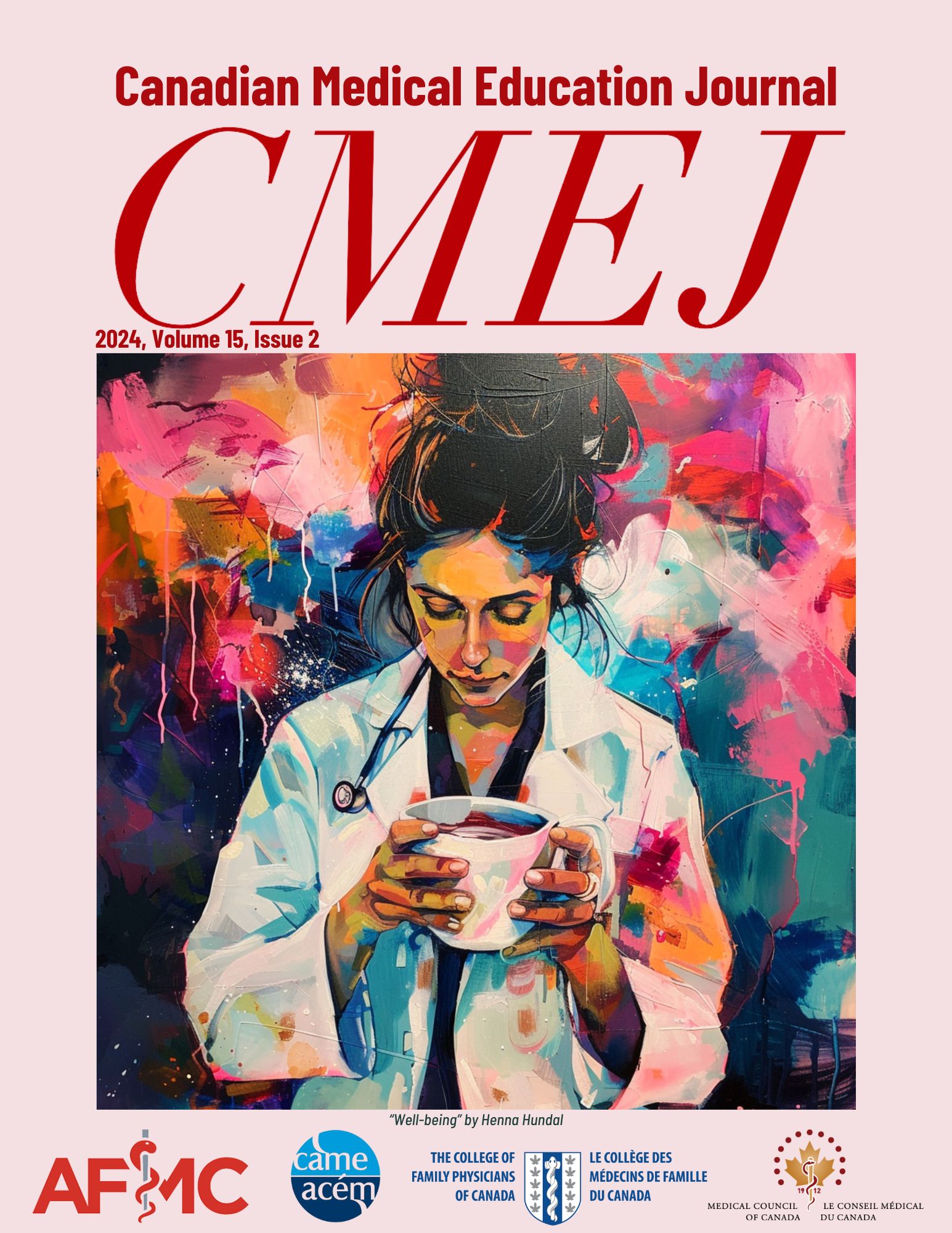Designing a touchless physical examination for a virtual Objective Structured Clinical Examination
DOI:
https://doi.org/10.36834/cmej.74261Abstract
Purpose: Given the COVID-19 pandemic, many Objective Structured Clinical Examinations (OSCEs) have been adapted to virtual formats without addressing whether physical examination maneuvers can or should be assessed virtually. In response, we developed a novel touchless physical examination station for a virtual OSCE and gathered validity evidence for its use.
Methods: A touchless physical examination OSCE station was pilot-tested in a virtual OSCE in which Internal Medicine residents were asked to verbalize their approach to the physical examination, interpret images and videos of findings provided upon request, and make a diagnosis. Differences in performance by training year were explored using ANOVA. In addition, data were analyzed based on a modified approach of Bloom's taxonomy of learning: knowledge, understanding, and synthesis.
Results: Sixty-seven residents (PGY1-3) participated in the OSCE. Scores on the pilot station were significantly different between training levels (F=3.936, p=0.024, ηp2=0.11). The pilot station-total correlation (STC) was 0.558, and the item-station correlations (ITC) ranged from 0.115 to 0.571, with the most discriminating items being those that assessed higher orders of learning (understanding and synthesis).
Conclusion: This touchless physical examination station was feasible, had acceptable psychometric characteristics, and discriminated between residents at different levels of training.
Downloads
References
Hopwood J, Myers G, Sturrock A. Twelve tips for conducting a virtual OSCE. Med Teach. 2021;43(6):633-636. https://doi.org/10.1080/0142159X.2020.1830961 DOI: https://doi.org/10.1080/0142159X.2020.1830961
Blythe J, Patel NSA, Spiring W, et al. Undertaking a high stakes virtual OSCE (“VOSCE”) during Covid-19. BMC Med Educ. 2021;21(1):221. https://doi.org/10.1186/s12909-021-02660-5 DOI: https://doi.org/10.1186/s12909-021-02660-5
Craig C, Kasana N, Modi A. Virtual OSCE delivery: The way of the future?. Med Educ. 2020;54(12):1185-1186. https://doi.org/10.1111/medu.14286 DOI: https://doi.org/10.1111/medu.14286
Boyle JG, Colquhoun I, Noonan Z, et al. Viva la VOSCE?. BMC Med Educ. 2020;20(1):514. https://doi.org/10.1186/s12909-020-02444-3 DOI: https://doi.org/10.1186/s12909-020-02444-3
Hytönen H, Näpänkangas R, Karaharju-Suvanto T, et al. Modification of national OSCE due to COVID-19 – Implementation and students’ feedback. Eur J Dent Educ. 2021;25(4):679-688. https://doi.org/10.1111/eje.12646 DOI: https://doi.org/10.1111/eje.12646
Mahrous A, Alammari R, Elgreatly A. Implementing virtual OSCE using an open-source online interactive 3D library. J Dent Educ. 2020;85(S1):1037-1039. https://doi.org/10.1002/jdd.12449 DOI: https://doi.org/10.1002/jdd.12449
Sartori DJ, Olsen S, Weinshel E, Zabar SR. Preparing trainees for telemedicine: a virtual OSCE pilot. Med Educ. 2019;53(5):517-518. https://doi.org/10.1111/medu.13851 DOI: https://doi.org/10.1111/medu.13851
Boardman D, Wilhite JA, Adams J, et al. Telemedicine Training in the COVID Era: Revamping a Routine OSCE to Prepare Medicine Residents for Virtual Care. J Med Educ Curric Dev. 2021;8:23821205211024076. https://doi.org/10.1177/23821205211024076 DOI: https://doi.org/10.1177/23821205211024076
Hatala R, Issenberg B, O Kassen B, Cole G, Bacchus M, Scalese R. Assessing the Relationship between Cardiac Physical Examination Technique and Accurate Bedside Diagnosis during an Objective Structured Clinical Examination (OSCE). Acad Med. 2007;82(10):S26-S29. https://doi.org/10.1097/acm.0b013e31814002f1 DOI: https://doi.org/10.1097/ACM.0b013e31814002f1
Courteille O, Bergin R, Stockeld D, Ponzer S, Fors U. The use of a virtual patient case in an OSCE-based exam–a pilot study. Med Teach. 2008;30(3):e66-76. https://doi.org/10.1080/01421590801910216 DOI: https://doi.org/10.1080/01421590801910216
Luke S, Petitt E, Tombrella J, McGoff E. Virtual evaluation of clinical competence in nurse practitioner students. Med Sci Educ. 2021;31(4):1267-1271. https://doi.org/10.1007/s40670-021-01312-z DOI: https://doi.org/10.1007/s40670-021-01312-z
White CB, Ross PT, Haftel HM. Assessing the assessment: are senior summative OSCEs measuring advanced knowledge, skills, and attitudes? Acad Med. 2008;83(12):1191-1195. https://doi.org/10.1097/acm.0b013e31818c6f6a DOI: https://doi.org/10.1097/ACM.0b013e31818c6f6a
Richardson JTE. 2011. Eta squared and partial eta squared as measures of effect size in educational research. Educ Res Rev. 2011;6:135-147. https://doi.org/10.1016/j.edurev.2010.12.001 DOI: https://doi.org/10.1016/j.edurev.2010.12.001
Ramani S, Ring BN, Lowe R, Hunter D. A pilot study assessing knowledge of clinical signs and physical examination skills in incoming medicine residents. J Grad Med Educ. 2010;2(2):232-235. https://dx.doi.org/10.4300%2FJGME-D-09-00107.1 DOI: https://doi.org/10.4300/JGME-D-09-00107.1
Wilson BE. Performance-based assessment of internal medicine interns: evaluation of baseline clinical and communication skills. Acad Med. 2002;77(11):1158. https://doi.org/10.1097/00001888-200211000-00023 DOI: https://doi.org/10.1097/00001888-200211000-00023
Chan SCC, Choa G, Kelly J, Maru D, Rashid MA. Implementation of virtual OSCE in health professions education: a systematic review [published online ahead of print, 2023 Apr 20]. Med Educ. 2023. https://doi.org/10.1111/medu.15089 DOI: https://doi.org/10.1111/medu.15089
Hess BJ, Kvern B. Using Kane's framework to build a validity argument supporting (or not) virtual OSCEs. Med Teach. 2021;43(9):999-1004. https://doi.org/10.1080/0142159X.2021.1910641 DOI: https://doi.org/10.1080/0142159X.2021.1910641
Cook DA, Brydges R, Ginsburg S, Hatala R. A contemporary approach to validity arguments: a practical guide to Kane’s framework. Med Educ. 2015;49(6):560-575. https://doi.org/10.1111/medu.12678 DOI: https://doi.org/10.1111/medu.12678
Downloads
Published
How to Cite
Issue
Section
License
Copyright (c) 2023 Wassim Karkache, Samantha Halman, Christopher Tran, Rui Nie, Debra Pugh

This work is licensed under a Creative Commons Attribution-NonCommercial-NoDerivatives 4.0 International License.
Submission of an original manuscript to the Canadian Medical Education Journal will be taken to mean that it represents original work not previously published, that it is not being considered elsewhere for publication. If accepted for publication, it will be published online and it will not be published elsewhere in the same form, for commercial purposes, in any language, without the consent of the publisher.
Authors who publish in the Canadian Medical Education Journal agree to release their articles under the Creative Commons Attribution-Noncommercial-No Derivative Works 4.0 Canada Licence. This licence allows anyone to copy and distribute the article for non-commercial purposes provided that appropriate attribution is given. For details of the rights an author grants users of their work, please see the licence summary and the full licence.











